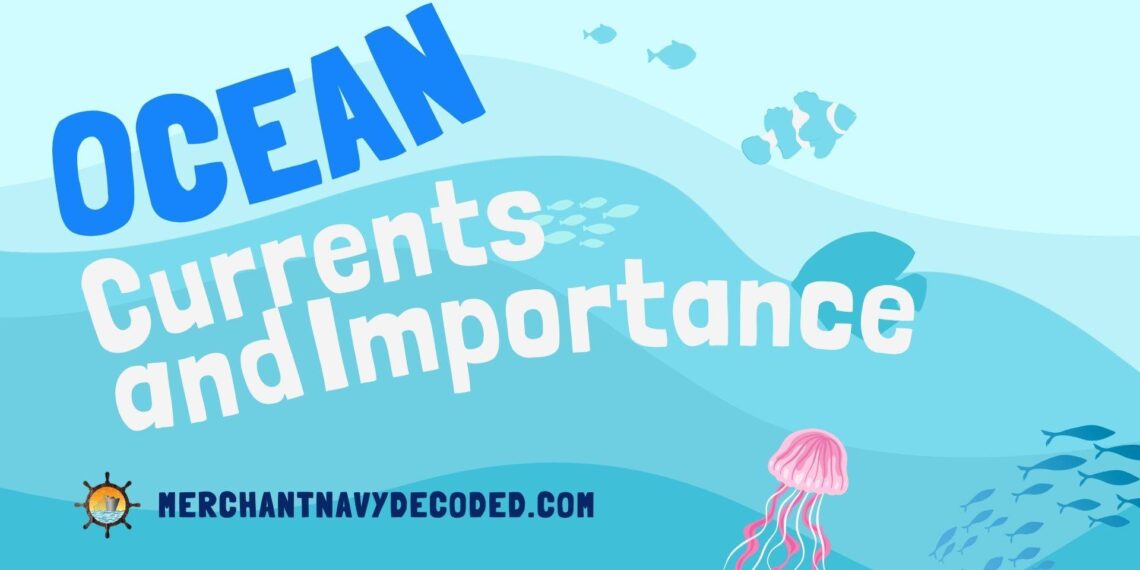What are Ocean Currents? Importance of Ocean Currents
1:- What are Ocean Currents
Whenever we hear the word “Current”, we immediately think of electricity that is in flow. Ocean Currents are somewhat like electric currents, with different driving forces.
2:- Ocean Currents Definition
Ocean Currents are a continuous and directed movement of seawater generated by forces like wind, the Coriolis effect, temperature and salinity differences, etc. You may visualize ocean currents as a large block of seawater having its sense of speed and direction
3:- Factors Influencing Ocean Currents
Ocean Currents are influenced by various factors, each contributing some part to the speed, direction, and behavior of these vast water bodies. Some of them are mentioned below:
- Wind: Wind acts on the surface of the water. It pushes the surface water towards the direction in which it is flowing. For example: Trade Winds and westerlies drive surface currents.
- Coriolis Effect: Due to the rotation of the earth which in turn creates the Coriolis force, ocean currents are deflected to the right in the Northern Hemisphere and the left in the southern hemisphere.
- Density Differences: Temperature and Salinity Differences combined are a major factor in driving ocean currents. Warmer water tends to rise and colder water sinks whereas an increase in salinity increases the density of the water.
- Gravitational Forces: Gravitational forces of the sun and moon cause tides which in turn cause tidal currents
- Basin Topography: The Natural Geography of the ocean basins can alter the direction of current. For Example, seamounts and underwater ridges can re-direct or block ocean currents
- Earthquakes and Storms: These may lead to temporary currents but may be as strong as seasonal currents, maybe even more.
It is to be noted that the primary source of all ocean currents is the sun.
4:- Different Types of Ocean Circulation:
Ocean currents can be divided into types based on the driving force. Ocean Circulation can be broadly classified into two types:
- Surface Circulation:
- Frictional Force is generated due to wind action on the top layer of the ocean water and Coriolis force. They can further be branched out into the following types:
- Wind-Driven Currents:

- The Global Wind Fields are majorly dominated by certain wind patterns that in turn lead to Ocean Currents. These are the Trade Winds, Westerlies, and Polar Easterlies.
- Gyres:

Gyres are Geostrophic Currents generated by a balance between the pressure-gradient force and the Coriolis effect. They have an Anti-cyclonic flow pattern, flowing clockwise in the Northern Hemisphere and Anti-clockwise in the Southern Hemisphere.
There are 5 major Gyres in the world:
- the North Atlantic
- the South Atlantic
- the North Pacific
- the South Pacific
- the Indian Ocean Gyre
- Boundary Current:
- Boundary Currents flow along the coastline of the continents and usually form a part of a large Oceanic Grye
- Coastal Upwelling:

- Upwelling is the phenomenon in which, Ekman transport deflects boundary current from the coast and deep ocean water rises to take its place. This is very important as this leads to the enrichment of surface water with essential nutrients and minerals.
5:- Warm and Cold Ocean Currents

On the basis of temperature, Ocean Currents can be classified as:
5.1:- Warm Currents:
These originate near the equator and travel toward the poles. Naturally, they are warmer than the water in their travel area.
- Key characteristics of warm currents:
- They warm the temperature of the air around them leading to milder climates.
- Warm Water Temperatures support a wider variety of Marine Life.
- Warm Currents influence the weather patterns often increasing precipitation on the coast
- Examples of Warm Currents:
- Gulf Stream, Kuroshio Current, Brazil Current
5.2:- Cold Currents:
As the name suggests, the temperature of cold currents is less than that of the water where the current travels. They Originate near the polar and sub-polar regions and move towards the equator.
- Key Characteristics:
- Cools the air above and hence leads to cooler coastal climates
- They often create dry and arid conditions as colder air loses ability to hold moisture
- These cold currents can often lead to foggy conditions.
- Examples of Cold Currents:
- California Current, Humboldt Current, Canary Current, etc.
6:- Ocean Currents of the World Map:
I believe it becomes easier to learn about these currents in smaller fragments, ocean by ocean. So here, we have divided all of the famous ocean currents of the world and grouped them according to the oceans.
6.1:- Ocean Currents in the Atlantic Ocean

- Warm Currents:
| Name | Originate |
| Gulf Stream | Originates in the Gulf of Mexico flows along the eastern coast of the United States and extends across the North Atlantic Ocean toward Europe |
| North Atlantic Drift | Continuation of the Gulf Stream across the North Atlantic towards Northwestern Europe. |
| Brazil Currents | Flows southward along the eastern coast of South America. |
| Antilles Currents | Flows northward east of the Antilles Islands in the Caribbean Sea. |
| Equatorial Currents | North Equatorial Current: Flows westward across the Atlantic Ocean just north of the equator. South Equatorial Current: Flows westward across the Atlantic Ocean just south of the equator. |
- Cold Currents:
| Name | Originate |
| Canary Current | Flows southward along the western coast of North Africa from the Iberian Peninsula to the coast of Senegal. |
| Labrador Current | Flows southward along the coast of Labrador and Newfoundland, merging with the Gulf Stream off the coast of the northeastern United States. |
| Benguela Current: | Flows northward along the southwestern coast of Africa. |
| Falkland (Malvinas) Current: | Flows northward along the eastern coast of Argentina, merging with the Brazil Current. |
| Greenland Current: | Flows southward along the eastern coast of Greenland, continuing into the North Atlantic. |
6.2:- Ocean Currents in the Pacific Ocean

- Warm Currents:
| Name | Originate |
| Kuroshio Current: | Flows northeastward from the Philippines past Taiwan and Japan into the North Pacific. |
| North Pacific Current (North Pacific Drift): | Flows eastward across the North Pacific Ocean between the Kuroshio Current and the California Current. |
| East Australian Current: | Flows southward along the eastern coast of Australia. |
| South Equatorial Current: | Flows westward along the equator from South America to the western Pacific Ocean. |
| Equatorial Countercurrent: | Flows eastward between the North and South Equatorial Currents, near the equator. |
- Cold Currents:
| Name | Originate |
| California Current: | Flows southward along the western coast of North America from southern British Columbia to Baja California. |
| Peru (Humboldt) Current: | Flows northward along the western coast of South America from southern Chile to northern Peru. |
| Oyashio Current: | Flows southward from the Bering Sea along the eastern coast of Russia and Japan. |
| West Australian Current: | Flows northward along the western coast of Australia. |
6.3:- Ocean Currents in the Indian Ocean:

- Warm Currents:
| A warm current flows southward along the eastern coast of Australia. | Originate |
| Agulhas Current: | Flows southward along the southeastern coast of Africa, from the Mozambique Channel to the southern tip of Africa. |
| Somali Current: | Flows northward along the eastern coast of Africa, from the equator to the Horn of Africa. It changes direction with the monsoon seasons. |
| North Equatorial Current: | Flows westward across the northern Indian Ocean, just south of the Arabian Sea and Bay of Bengal. |
| South Equatorial Current: | Flows westward across the Indian Ocean, just south of the equator. |
| East Australian Current: | A warm current that flows southward along the eastern coast of Australia. |
- Cold Currents:
| Name | Originate |
| West Australian Current | Flows southward along the southeastern coast of Africa, from the Mozambique Channel to the southern tip of Africa. |
| Southwest Indian Ocean Current | Flows northward along the eastern coast of Africa, from the equator to the Horn of Africa. It changes direction with the monsoon seasons. |
6.4:- Ocean Currents in the Arctic Ocean:

- Warm Currents:
| Name | Originate |
| Norwegian Current: | Flows northeastward along the coast of Norway into the Barents Sea. |
| West Spitsbergen Current: | Flows northward along the west coast of Spitsbergen (Svalbard) into the Arctic Ocean. |
- Cold Currents:
| Name | Originate |
| East Greenland Current | Flows southward along the eastern coast of Greenland. |
| Beaufort Gyre | A clockwise circular current in the Beaufort Sea, north of Alaska and Canada. |
| Transpolar Drift Stream: | Flows from the Siberian coast across the central Arctic Ocean towards the North Atlantic. |
Some of the additional Currents in the Arctic Sea are the Chukchi Sea Circulation, the Siberian Coastal Current, the Canadian Arctic Archipelago Throughflow and the Fram Strait Outflow.
6.5:- Ocean Currents in the Southern Ocean
The currents in the Antarctic Ocean are the mighty Antarctic Circumpolar Current encircling the continent itself, the Antarctic Coastal Current (East Wind Drift) flowing westward, the cold recirculating Gyres of Weddell and Ross, most importantly, boundary currents like the Polar Front, Subantarctic Front, Agulhas Return Current, South Pacific Current, and Drake Passage Current, and these together contribute much to global thermohaline circulation, nutrient disposition, and climatic regulation.
7:- Importance of Ocean Currents
These currents have played the most vital role in this climate, supporting marine life and influencing human activities. Understanding the importance of ocean currents is a must to fully appreciate their impact on our planet.
- Temperature Influence: Ocean currents transport warm and cold waters across long distances, affecting regional climates.
- Examples: The Gulf Stream carries warm water northward, warming western Europe, while the California Current brings cold water southward, cooling the western coast of North America.
- Weather Formation: Warm currents bring humid, wet conditions, while cold currents create drier, arid climates.
- Effect on Extreme Weather: Ocean currents shape storm tracks, precipitation patterns, and the intensity of extreme weather events.
- Thermohaline Circulation: This large-scale system, also known as the global conveyor belt, distributes heat globally.
- Climate Balance: It moves warm surface water towards the poles and brings cold, nutrient-rich water to the surface, maintaining stable temperatures and preventing extreme climate changes.
8:- Conclusion
It can really be imagined that ocean currents are a great force and beauty of full beauty, showing just how absolutely intricate the marine environment of our planet is. Therefore, these gigantic rivers continue to flow within the sea, dictating the kinds of distribution of warmth, nutrients, and marine life characteristics throughout the earth’s climate patterns and ecosystems.
Disclaimer :- The opinions expressed in this article belong solely to the author and may not necessarily reflect those of Merchant Navy Decoded. We cannot guarantee the accuracy of the information provided and disclaim any responsibility for it. Data and visuals used are sourced from publicly available information and may not be authenticated by any regulatory body. Reviews and comments appearing on our blogs represent the opinions of individuals and do not necessarily reflect the views of Merchant Navy Decoded. We are not responsible for any loss or damage resulting from reliance on these reviews or comments.
Reproduction, copying, sharing, or use of the article or images in any form is strictly prohibited without prior permission from both the author and Merchant Navy Decoded.




